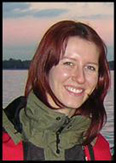The Ocean Research Group
Emma Harrison
PhD student

PhD working title: The role of the bacterioneuston in air-sea gas exchange
Supervisors: Professor Rob Upstill-Goddard (Newcastle) and Professor Colin Murrell (Warwick University)
I have a multidisciplinary background in Environmental Science and Oceanography which has mainly focussed on atmospheric trace gases and biogeochemistry. During my MSc, I specifically focussed on halocarbon production by Phaeocystis globosa and Emiliania huxleyi and investigated how this production varied under different carbon dioxide concentrations (380ppm and IPCC projected concentrations in the year 2100 of ~700ppm).
My PhD is focussed on the sea surface microlayer which is the top 1 - 1000 µm of the ocean surface. The uppermost region of the sea surface microlayer is known as the bacterioneuston and appears to have a distinct bacterial composition. Comparisons of bacterial diversity between the bacterioneuston and the subsurface waters show clearly that there are distinct differences between the two; it is estimated that the bacteria within the microlayer are 103 – 105 times more abundant than in subsurface waters.
The bacterioneuston forms an important boundary between the ocean and atmosphere and it is believed that microbial metabolism of climatically active trace gases such as methane and nitrous oxide in this region, may exert important controls on air-sea gas exchange.
Determining the diversity, abundance and activity of the major groups of microorganisms in the bacterioneuston and their involvement in trace gas cycling, are a high SOLAS priority. Investigation into the bacterioneuston is difficult, but here at Newcastle the development of a purpose built gas exchange tank coupled with two fully automated gas chromatographs to measure methane and nitrous oxide concentrations, will significantly increase our understanding of gas cycling within the upper ocean.
For further information see our SOLAS bacterioneuston pages